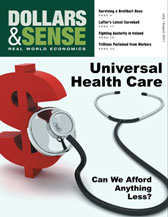This article is from Dollars & Sense: Real World Economics, available at http://www.dollarsandsense.org

This article is from the July/August 2011 issue of Dollars & Sense magazine.
Subscribe Now
at a 30% discount.
The Wrong Medicine
Why fiscal austerity is a bad idea for a slumping economy.
As protesters take to the streets in Europe to oppose government spending cuts, proponents of austerity in the United States and Europe claim that immediate moves to reduce government deficits are the way to renewed economic growth. Accepting a little pain now, they argue, will reduce the pain in the long run.
Those familiar with Keynesian economic theory will find the austerity-to-growth claims surprising. Fiscal austerity, or a “contractionary fiscal policy,” means either spending cuts or tax increases, or a combination of the two. Reductions in government spending reduce total demand directly. Government spending on real goods and services is just as much a part of total demand as private consumption or investment spending. Spending cuts can also reduce demand indirectly, as those who would have received income as a result of government spending cut back on their spending as well. Tax increases reduce demand by reducing the disposable incomes of private individuals, who then spend less. Either way, lower demand for goods and services can translate into less output and employment.
How, then, is fiscal contraction supposed to lead to growth? Austerity proponents argue that balancing government budgets and reducing public debt will boost private-sector “confidence.” As public debt increases, the argument goes, people may become wary about spending, since they will be on the hook (through taxes) to pay down that debt in the future. Individuals and firms will spend more freely now if they do not have future taxes hanging over their heads.
The pro-austerity faction has relied heavily on a few recent studies, especially one by Harvard economists Alberto Alesina and Silvia Ardagna claiming to have identified 26 cases in which fiscal contraction led to renewed growth. This conclusion, however, has not stood up to careful scrutiny. Economists Arjun Jayadev and Mike Konczal, after studying the cases that Alesina and Ardagna describe, find that “in virtually none did the country a) reduce the deficit when the economy was in a slump and b) increase growth rates while reducing the debt-to-GDP ratio.”
In 20 of the 26 cases, Jayadev and Konczal argue, the government did not carry out a fiscal contraction during the low (or “slump”) phase of a business cycle. (Budgets are much easier to balance, and debt easier to pay down, during the “boom” phase of a business cycle. With output and incomes high, total tax revenue is bound to be high as well, while expenditures on things like unemployment insurance are bound to be low.) Out of the six remaining cases, they find, the rate of economic growth actually declined in five. Looking at a broader sample of countries engaging in austerity, Jayadev and Konczal find that, in most cases, deficit cutting during a slump results in lower growth. Even in most of the cases where the growth rate did increase, the ratio of debt to gross domestic product actually increased as well. This suggests that, even if fiscal austerity had some effect in reducing the growth of total debt, it also resulted in such weak overall economic growth that the debt burden (relative to GDP) continued to rise.
Austerity can actually undermine a country’s ability to reduce its government deficit and debt, and increase the interest rates a government is forced to pay on its debt. A government’s ability to borrow depends on the size and stability of the economy that it has the power to tax. By cutting demand, a government may prolong a slump. The longer the slump goes on, the longer tax revenues will remain below normal, and the longer the government will have above-normal expenditures on items like unemployment insurance. If investors conclude that the slump is bound to go on for a long time, and that the government will therefore be a bad credit risk for the foreseeable future, they will demand a higher interest rate (to compensate them for that risk). This, too, will tend to increase the government’s debt burden.
Austerity advocates present themselves as tough-minded and pragmatic—not flinching from the painful sacrifices necessary for a better future. The facts might suggest, instead, that fiscal austerity during a slump amounts to cutting off one’s nose to spite one’s face. Except that, as the protests raging in Europe show, it is other people’s noses that the pro-austerity faction aims to lop off.
Did you find this article useful? Please consider supporting our work by donating or subscribing.
